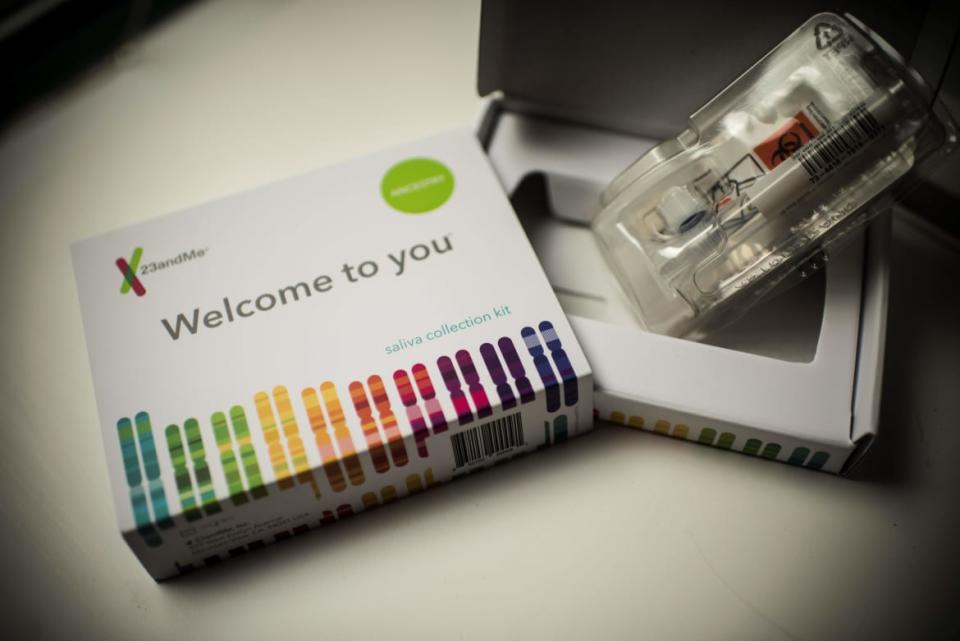The Dark Side of the At-Home Health Test Boom

Like most Americans during the early days of the COVID-19 pandemic, my husband and I did a poor job eating healthy and staying fit. We started a Chicago burger challenge where we would sample a new spot each week and score it on a scale of 1 to 10. My at-home ballet barre collected dust as the weeks went by. Rather than make some serious moves to improve our physical health, we decided we’d put off any sudden diets and exercise regimens and instead ascertain a full lay-of-the-land of our internal health first.
We turned to InsideTracker, a company that promises to “transform your body’s data into science-based action plans.” Just a little bit of blood, and boom—personalized reporting on everything from your “internal age” to whether or not you’re getting enough sleep according to your genes.
After receiving our results, I noted an off-the-chart reading for my sex hormone-binding blobulin. After some morbid Googling that led me to self-diagnose a liver disease, I finally reached out to my doctor to see what exactly these levels meant and whether there really was cause for alarm. She reviewed the results and concluded that hormonal birth control can cause the abnormalities present in my test.
This seemed like a fairly simple explanation that you would expect a test that costs $589 to be able to deliver directly. The experience made me consider if these tests had any measurable impact on wellness, or if they were just shrewdly marketed and capitalized on a moment when at-home health care blew up.
The Post-COVID Doctor Shortage Is a Ticking Time Bomb. Here’s How to Diffuse It.
Americans are obsessed with the ideals of “freedom” and “independence”, so it’s no surprise that consumers are asking for more from medicine. We want to do it ourselves, and we want the “it” to be as unique as we are. Consulting firm McKinsey reported in 2019 that “personalization will be the prime driver of marketing success within five years,” and we’re well on our way down that path.
Personalized medicine, specifically, has been around since as long as modern medicine itself. But Dr. Jeffrey Dlott, medical director of consumer health for Quest Diagnostics, told the Daily Beast he has noticed a “shift towards more consumer-centric health care over the past few years,” even prior to the COVID-19 pandemic. Recent studies show that first-year physicians spend almost 90 percent of their time away from patients, despite the fact that longer visits correlate with positive patient outcomes. The pandemic accelerated virtual care, said Dlott, even while patients faced escalating questions about their health and had no way of connecting with the health-care system in a traditional way. Direct-to-consumer testing has helped fill these gaps to some extent.
Moreover, the pressure to justify health-care decisions to insurance companies can cause doctors to simply forgo testing that may be useful but not critical, leaving patients to do some of their own sleuthing. Priya Raj, a sustainability writer from Glasgow, told The Daily Beast that after a vague IBS diagnosis for some of the issues she was experiencing, she opted for a food sensitivity test offered by YorkTest. “My doctor sort of kindly declined to do any testing so I thought I’ll pay for it myself,” she said.
Consumers like Priya have no problem finding tests to take at home. The FDA outlines several categories of “in-vitro diagnostics” offerings, including “direct-to-consumer'' (DTC) tests that do not require a healthcare provider to procure, but are often sent to a laboratory for result processing. They can determine your risk of developing certain diseases or illuminate protein and toxin levels in your body. These are typically blood-, saliva-, or urine-based tests, part of an increasingly lucrative market that is expected to be worth $2.6 billion globally by 2025.
And there are some clear benefits for consumers. Jackie Clemente, a California woman in her thirties, took a chance with KindBody’s at-home fertility test offering to get a sense of her reproductive outlook. With a finger prick of blood, the test measures the presence of Anti-Mullerian Hormone (AMH), important to ovarian function.
“It's been so empowering to take the wool off my eyes, get a real understanding of exactly what I'm dealing with, and have the power to make decisions on the next steps that I want to take,” Clemente told The Daily Beast. KindBody also offers the option to review a consumer's results with a fertility doctor, which she plans to take advantage of.
Yet there are also some blind spots to these tests that haven’t yet been fully evaluated. For starters, many of these testing companies are acquiring massive user datasets that are ripe for monetization, bringing about head-spinning implications on data rights and privacy. Patient data, even when properly safeguarded, de-identified and “opted in,” often lies at the heart of the revenue engine of health care these days, and is a byproduct of DTC testing. For example, 23andMe made headlines in recent years after inking a $300 million deal with GlaxoSmithKline to collaborate on the development of new medical treatments. Under the deal, 23andMe offers up the genetic data it collects from these tests for use in discovering new drugs to combat disease.
And despite their expanding reach, these tests can be prohibitively expensive and are often covered out-of-pocket, though some are covered by FSA and HSA plans. (Many people currently fighting to get at-home COVID tests covered by their insurance will understand this.)

A saliva collection kit for DNA testing by 23andMe, displayed in Washington DC on December 19, 2018.
Even when obtainable, the tests are not guaranteed to be useful. New Jersey resident Dawn Um suffered from reactions to food that would lead to extreme fatigue or cause inflammation in her joints. She told The Daily Beast that she tried a food sensitivity test (similar to the York Test) made by at-home testing startup Everlywell.
After reviewing her results, Dawn noted that no foods came up as inflammatory, despite her body’s pleading signals to the contrary. She called the service “a waste of money,” and continues to look for clues into the root causes of her ailments on her own.
Um’s experience isn’t entirely surprising. Many food sensitivity tests work by looking for reactivity levels of the IgG antibody, which is known to play a role in food allergies. But studies have shown that using IgG as a proxy measure for allergic reactions doesn’t always work. The tests are often quick to cover their bases by pointing out that they are a measure of sensitivity, not allergy.
Unregulated Territory
Um is far from alone in her disappointment, and the FDA is partly responsible. Everlywell’s tests are classified as “Laboratory Developed Tests,” (or LDTs), and these tests can typically bypass formal FDA premarket approval and other requirements. DTC tests that sit outside of LDT classification are regulated by the FDA as “medical devices” that must undergo some version of review—depending on their level of risk to patients. The mixed standards applied to these tests have created an enormous amount of confusion for consumers attempting to make informed decisions about their health using tests that have variable thresholds for government oversight. The FDA acknowledged its “intent to reconsider its policy of enforcement discretion for LDT’s” in 2010, and issued a discussion paper on the topic in 2017. But it has done little to materially change the approval landscape.
And of course, worse than being unhelpful is the potential for these tests to return a misleading result or one that’s difficult to properly interpret, which could lead to mistreatment of a condition. One case study published in Genetics in Medicine serves as a cautionary tale: A 47-year old woman with a family history of breast cancer took an at-home 23andMe genetic test showing a “low risk for breast cancer”—in spite of the fact that a genetic test run through a clinic the previous year revealed she carried a pathogenic variant of the BRCA2 gene that greatly increases breast cancer risk. Upon extensive review of her 23andMe results, the patient noticed a disclosure that the test was “not exhaustive of all BRCA mutation forms.” Had she relied only on the 23andMe test, any health-care decisions made moving forward would have been based on inaccurate evaluations of her health.
“Lab tests do not diagnose patients; health-care practitioners do,” said Dlott. He underscored the importance of developing and maintaining a strong physician-patient relationship, and providing clinical oversight to testing, regardless of the delivery mechanism.
So why do we pursue these tests if they are often expensive overkill and may not even work as they’re supposed to? To some extent, human curiosity simply wins out. Some of these tests are just flat-out fascinating, like the knowledge that my eight-hour-a-night sleep needs are genetically encoded.
But more importantly, “people want to take more control over their health,” explained Dlott. Good health is a form of currency and privilege—a sentiment that the health and wellness industry has been able to exploit in order to attract new consumers. Direct-to-consumer testing is just the latest step in that pursuit.
Months later, I can’t say my test made me significantly healthier (though we did discontinue our burger challenge.) The intense profit motives and lack of clear regulation has created a glut of white testing kits that we can add to our cart in a click and send to our homes—without any guarantee they’ll play a positive, reliable role in our personal healthcare.
Until transparency and clinical actionability can be balanced with innovation and the bottom line, these tests are band-aids—and potentially even enablers—to a system that’s a bit more broken. Health care that truly empowers patients would arm them with both the information and confidence to ponder their medical decisions wherever they are, not just a physician’s office.
Get the Daily Beast's biggest scoops and scandals delivered right to your inbox. Sign up now.
Stay informed and gain unlimited access to the Daily Beast's unmatched reporting. Subscribe now.

